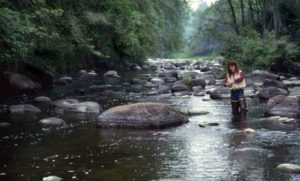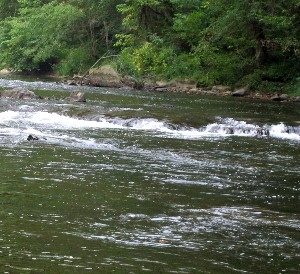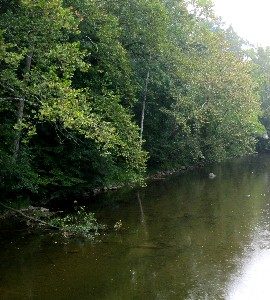Using some simple techniques and looking for certain things you can still enjoy productive smallmouth bass fishing.
One of the most challenging situations for the smallmouth bass fisherman is when streams and rivers get low and extremely clear. The hot, dry days of summer can take their toll, causing stream flows to drop off significantly. Adding even more misery, the reduced flow causes the water to become super clear. So clear that at times it may seem you are viewing the bottom through nothing more than a sheet of glass and your every move is telegraphed through the water at the speed of light.

Angler probes a hot low-water smallmouth bass spot.
On this face of it, this sounds like conditions that should provide a smallmouth fishing bonanza. With all the bronze concentrated in small, predictable spots in a given stretch of water, it should be like shooting fish in the proverbial barrel. If only it were that simple. But, unfortunately, it isn’t. The concentrating of the fish is not the only dynamic at work in this situation.
One thing to remember is that the world is not only getting smaller for Mr. Bronzeback, it is also getting smaller for the forage species of the flow. This concentrates the food as well as the smallmouth bass in a given stretch. Making it easier for the smallies to get a meal, and your lure becomes just one of many feeding opportunities
All is not lost though. Using some simple techniques and looking for certain things you can still enjoy productive smallmouth bass fishing. In this article I am going to tell you about some of the things I do when faced with these tough conditions.
Stealth Techniques for Low-Water Smallmouth
More than in any other situation, stealth is important when approaching any spot potentially holding smallmouth bass during a low-water period. I try to be aware of everything around me and all my movements while getting into position to fish an area.
Keeping a low profile as you move along and in the stream is very important. If I can see directly into the area I am about to fish, any smallmouth bass holding there can likely see me also. This is especially true when moving along high stream or river banks. The high vantage point will make your silhouette stand out like a sore thumb. For this reason I try to make my approach crouched down, or even on my knees in some cases. At the very least I try to use any streamside vegetation to break up my form.

Deep runs can be a gold mine for low-water bronze.
I also try to stay aware of my position in relation to the sun and where my shadow is being cast. Since a number of threats to a smallmouth bass’s well being come from above they are very aware of movement and shadows cast above them. While it may be just your head happily bobbing along as you plunder along the stream bank, to a smallmouth it could very well look like the shadow of a swooping bird of prey.
When moving in the water, your profile is not the only thing you need to remain aware of. Wading technique is extremely important too. Nothing in the world will send a pod of low-water smallmouth bass scampering for parts unknown like a sloppy wader sloshing through the stream. I always wade carefully to minimize the noise and disturbance created on the water’s surface.
Using Tim’s “Wader’s Shuffle” approach helps me move quietly into position. If you are not familiar with this technique (described in both his spin and fly books) you will be rewarded handsomely in situations like this by employing it.
I also attempt to approach from a downstream position whenever possible. Wading upstream helps to conceal your movements. Any sound or disturbance is less likely to make its way to the smallmouth when downstream of the fishing spot. The current will help carry any mistakes harmlessly downstream.
Low-Water Smallmouth Bass Lures
No discussion of a smallmouth bass fishing situation would be complete without at least a cursory look at lures. As I would at any other time of the year, I still look to make presentations in all three major zones of the water column – top, middle and bottom. The only thing I usually change up is size and in some cases color choices.
Now, I am not what you would call a “color” person. It is my opinion that in river smallmouth bass fishing a proper presentation trumps color choice almost every time. However, low-water is one time that I do pay a little more attention to color.
In low-water I tend to choose more natural and subdued colors. I also try to match the predominant forage in the river or stream if possible. In the arena of bottom bouncing lures like tubes, it is harder to “match the hatch”, but choosing a lure color that closely matches the color of the bottom substrate will put you in the ballpark.
Lure choice is another area where subtle is the keyword. Low-water is not the best place to throw that new super-rattling crank bait. Something that is a bit quieter with less pronounced action is the best ticket in low flows. For me, nothing seems to produce as well as the tried and true minnow-style baits. Nothing mimics the quiet movements of a baitfish quite as well.
One other tip on lure selection for low-water is to think small. I always seem to have more success when I step down a size or two from what I would normally throw on a given stretch of water. For instance, if I would normally throw a 3 1/2″ minnow bait on a given stream, when fishing that area in low-water I would step down to around a 3″. It is my opinion that the smaller size may help mask that the offering is artificial and make it appear more natural.
Low-Water Smallmouth Hot Spots
A full review of all possible holding areas for late summer-early fall smallmouth bass is a bit outside of the scope of this article. For a complete discussion of this topic I recommend checking out Tim’s new book, River Smallmouth Fishing. He covers this information in depth and much better than I could ever do it. However, I am going to go over some characteristics of the spots that I look for when the flows are low and clear.
The first thing I look for when chasing low-water smallmouth bass is water depth. Smallies faced with dropping water levels generally seek out the deepest pockets in the area to hold in. Deep water in this case is a relative term and varies from flow to flow. Generally, I search out areas that are significantly deeper than other nearby areas. For instance, a 3 foot deep run in an area where most of the water is a foot or less deep is an excellent bet.
Once I locate a deep water area I look for other factors that will make it attractive to smallmouth bass. Cover is an important feature for any holding area. Not only does it provide security, it also offers the smallmouth ambush points for feeding. I like to see a mix of rock sizes anywhere from small boulders to softball sized stones.
While rocks and boulders are usually the first thing that comes to mind when thinking of smallmouth bass cover, don’t overlook wood. A submerged tree or limb is also an excellent target to probe for bronze. Actually, that wood doesn’t even have to be submerged to provide effective cover for smallies.

Overhanging trees make a great hiding
spot for low-water smallies.
Some of my favorite holes for low-water smallmouth are ones shielded by cover above the surface. This can be anything from overhanging trees and brush to a nice undercut bank. The shade created by this kind of cover not only provides great protection from non-aquatic predators, it also provides a bit of relief from the heat of a summer day. An area like this with a bit of moderate current and some rocks can provide a real low-water hot spot. So, don’t limit your idea of cover to only objects in the water.
The final thing I consider when evaluating a spot is how approachable it is. You can have the best spot in the whole river in front of you, but unless you can get into a position to fish it effectively without spooking its residents it is absolutely worthless. Spots with nearby riffles or fast water are excellent because the noise and surface disturbance caused by the moving water will conceal your movements. The most ideal situation though is a spot than you can fish from the bank. By staying out of the water completely and using the streamside vegetation to cover your movements is the best way to make a stealthy approach.
I hope my ideas and tips on low-water smallmouth bass fishing will help you find success the next time you are faced with these tough conditions. Pulling a couple nice smallies out of a stretch of river where the water is mostly ankle deep is quite rewarding. But, even if you don’t manage to catch some bronze it doesn’t make the day a total loss. You can always turn it into a wonderful opportunity to learn.
Low-water provides an excellent chance to investigate those hot spots that always seem to hold fish during normal flow conditions. Maybe you can find some other spots just like it to try when the things get back to normal. Either way, fish or not, you can have a productive day on the water. So, make the most of a low-water situation.


No comments yet.